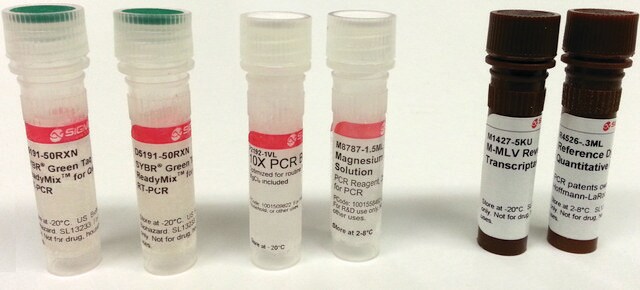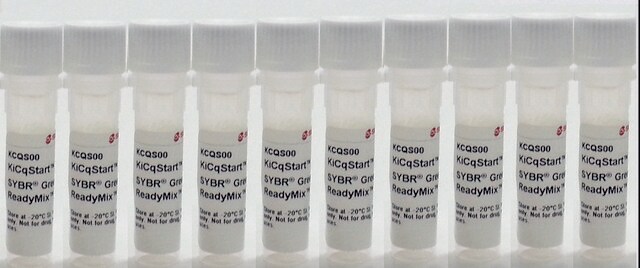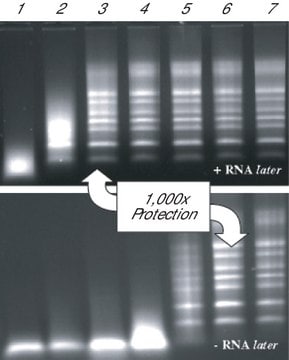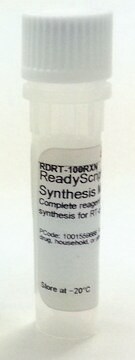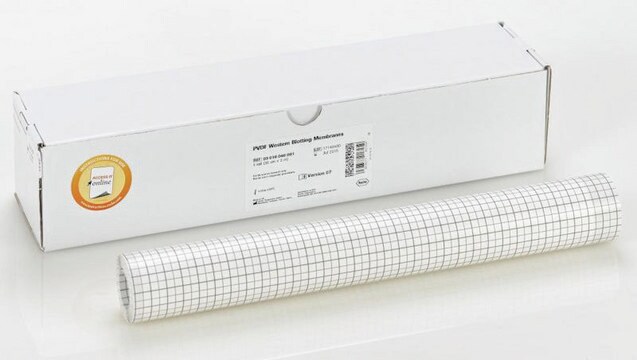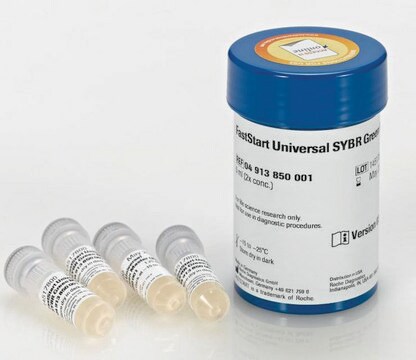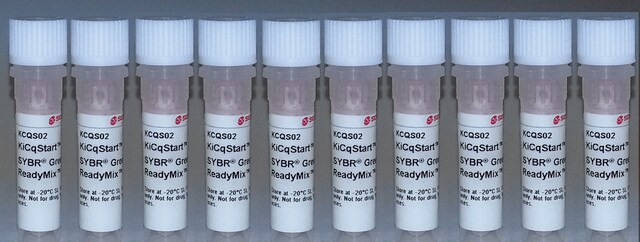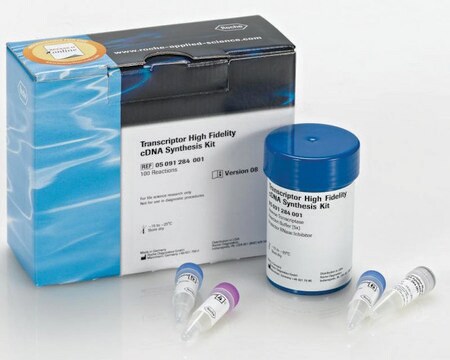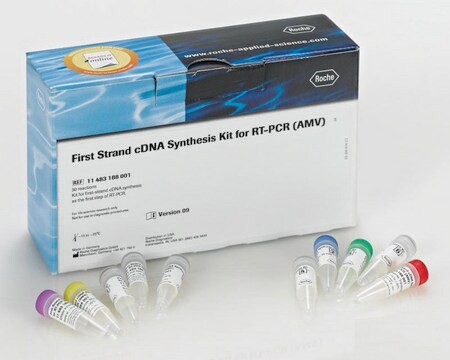SF1UKB
Roche
KAPA SYBR® FAST One-Step
suitable for RT-PCR, 2 ×, Universal
Synonym(s):
SYBR, qPCR
About This Item
Recommended Products
Quality Level
usage
sufficient for 100 reactions
sufficient for 1000 reactions
sufficient for 500 reactions
shelf life
≤6 mo.
feature
dNTPs included: no
hotstart: no
packaging
kit of 1 mL (100 x 20 μL rxn; KK4650)
kit of 10 mL (1000 x 20 μL rxn; KK4652)
kit of 5 mL (500 x 20 μL rxn; KK4651)
manufacturer/tradename
Roche
concentration
2 ×
technique(s)
RT-PCR: suitable
qPCR: suitable
input
purified DNA
compatibility
for use with Agilent Mx3000P
for use with Agilent Mx3005P
for use with Agilent Mx4000
for use with Applied Biosystems® 5700
for use with Applied Biosystems® 7000
for use with Applied Biosystems® 7300
for use with Applied Biosystems® 7500
for use with Applied Biosystems® 7700
for use with Applied Biosystems® 7900HT
for use with Applied Biosystems® ViiA 7
for use with QuantStudio™
for use with StepOne™
for use with StepOnePlus™
detection method
SYBR® Green
storage temp.
−20°C
Looking for similar products? Visit Product Comparison Guide
General description
KAPA SYBR FAST One-Step qRT-PCR Kits contain M-MuLV reverse transcriptase, RNase inhibitor, and a novel DNA polymerase evolved via directed evolution.
Application
- Gene expression analysis
- Low-copy gene detection
- Microarray validationmiRNA research
- Gene knockdown validation
- Real-time quantitative reverse transcription-PCR (qRT-PCR)
- RNAi and miRNA research
Features and Benefits
- Consistently higher amplification efficiencies for accurate qPCR.
- Higher fluorescence, earlier Cq values and improved reaction efficiencies.
Amplify across a broad range of target lengths
- Robust performance independent of amplicon size.
- Improve sensitivity and reproducibility
- Accurate interrogation across a wide range of RNA template concentrations.
Quick Notes:
- This kit contains wild-type M-MuLV and an engineered enzyme optimized for qPCR using SYBR Green I dye chemistry.
- The 2X master mix contains a proprietary buffer. Together with the novel enzyme, this improves amplification efficiency of both GC- and AT-rich targets.
- Use only gene-specific primers for one-step qRT-PCR.
- Optimal cDNA synthesis is achieved at 42°C for 5 min.
- 3 min at 95°C is sufficient for RT inactivation and DNA polymerase activation.
- For 3-step cycling, use 20 sec for primer annealing and 1 sec for extension/data acquisition at 72°C.
- Do not exceed 25 μL reaction volumes.
Quality
Preparation Note
The SYBR Green I dye contained in the KAPA SYBR FAST qPCR Master Mix (2X) and ROX/fluorescein dyes (depending on kit configuration) are light sensitive. Exposure to direct light for an extended period of time will result in loss of fluorescent signal intensity.
KAPA SYBR FAST qPCR Master Mix (2X) is stable through 30 freeze-thaw cycles. Ensure that all reagents are stored protected from light at -20°C when not in use. When protected from light, reagents are stable in the dark at 4°C for at least one week and may be stored at this temperature for short-term use provided that they do not become contaminated with microbes and/or nucleases.
Other Notes
Legal Information
Kit Components Only
- KAPA RT Mix
- dUTP
- KAPA SYBR® FAST DNA Polymerase
- reaction buffer
- dNTPs
- SYBR® Green I dye
- MgCl2 2.5 mM
signalword
Warning
hcodes
Hazard Classifications
STOT SE 2
Storage Class
12 - Non Combustible Liquids
wgk_germany
WGK 1
flash_point_f
does not flash
flash_point_c
does not flash
Choose from one of the most recent versions:
Certificates of Analysis (COA)
Don't see the Right Version?
If you require a particular version, you can look up a specific certificate by the Lot or Batch number.
Already Own This Product?
Find documentation for the products that you have recently purchased in the Document Library.
Articles
An overview of directed evolution and the methods for generating proteins with optimized or entirely new functions.
Our team of scientists has experience in all areas of research including Life Science, Material Science, Chemical Synthesis, Chromatography, Analytical and many others.
Contact Technical Service